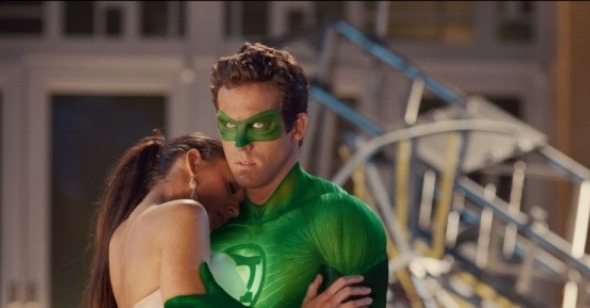Monday Hangover
The Green Lantern
By Adam Nayman and Keith Uhlich
It’s not fun to watch a favorite actor fail. Much to the confusion (and amusement) of certain of my friends, I’ve cultivated a great fondness for Ryan Reynolds over the years, probably ever since his preternaturally snappy line readings on the late, and unlamented, ABC sitcom Two Guys, a Girl, and a Pizza Place. Reviewing Roger Kumble’s underrated Just Friends, Reverse Shot’s own Nick Pinkerton put a finger on Reynolds’s strong if slightly irregular comic pulse: “His standby shtick is meandering through a line reading with a vacillating tone before snapping it out, quick and nasty, through an immaculate clenched smile.” Reynolds has struck a few different notes in his work since then—I liked his unraveling efficiency expert in Marcos Siega’s clumsy but affecting seriocomic Chaos Theory and loved his rueful amusement-park mechanic in Adventureland. Those performances smartly undermined Reynolds’s good looks, as did his harrowing one-man show in last year’s Buried: being contorted in a dark coffin for ninety minutes is a good way to make sure nobody’s looking at your abs. Once again, I defer to Nick’s wisdom: “When it’s time to put that leading man jawline to its proper use, he [Reynolds] can seem out of his element.”
Which brings us to Green Lantern and Reynolds’s failure therein. His turn as fighter-pilot-turned-cosmically-endowed-Earth-defender Hal Jordan signifies something rarer and more disappointing than bad casting: good casting gone horribly awry. Part of the blame goes to the filmmakers—director Martin Campbell and his dim Lantern Corps of screenwriters—for giving an actor so adept at sly, insinuating asides such a hangdog role. There are few opportunities for Reynolds’s Jordan to seem chuffed that he’s been given the keys to the DC Comics kingdom. The montages of him discovering his mind-into-matter superpowers are rushed and perfunctory, and there are far too many scenes staged for the express purpose of reminding us that this seeming daredevil harbors guilt and anxiety over the long-ago death of his missile-jockey father (after a while, I was reminded, not unpleasantly, of Robert Hays’s hang-ups in Airplane!, although sadly the Green Lantern doesn't have a “drinking problem”).
That said, Reynolds doesn’t hold up his end, either. He recedes too willingly amidst the incessant special effects and smooshed plotting—which involves something about a fear-based space cloud trying to take over our world by infecting and mutating a scientist (Peter Sarsgaard) until he looks like a bulbous John Carpenter. That Green Lantern is so poorly designed and executed is maybe not a surprise: Campbell’s specialty has always been rugged, spatially precise stunt sequences as opposed to CGI showcases, and it seems like he’s following orders rather than trying to shape the material uniquely (or even just trying to conjure goofy good vibes à la Kenneth Branagh with Thor). I had been looking forward to seeing one of my pet causes headlining a summer mega-spectacular, and I ended up wishing they’d gone with somebody else: it would have been a lot more fun to write that, say, Bradley Cooper had choked behind the cowl. Oh, well. —AN
I’m one of those, Adam, who doesn’t see Reynolds’s appeal beyond the exaggeratedly carnal (how often I’ve stared, at once turned on and snickery, at those Blade: Trinity shirtless shots). To me, he’s a good chest and little else, though I wouldn’t profess any confusion over your fondness for him as a performer. We all view cinema and its denizens differently, and you’ve laid out a strong and assured case for Reynolds’s various talents. None of which, it seems we agree, are on display in Green Lantern.
The major problem: The film spends way too much time on Earth. To use one of your descriptions, this is where things feel most perfunctory. We get a sluggish love story (Blake Lively . . . ugh), a humdrum villain (Sarsgaard’s Elephant Man-esque monomaniac), and the great Angela Bassett (a long ways away from Strange Days glory) wasted as an expository fount. I share your admiration for director Martin Campbell, and also esteem editor Stuart Baird (who can cut an action scene with the best of them) and cinematographer Dion Beebe (who did moody, mesmerizing work on Michael Mann’s Miami Vice), but nothing they do here goes beyond dutiful hackwork. Reynolds, meanwhile, leads by the chin; he’s a square-jaw going through the origin story motions. If I had more investment in the actor, I’d perhaps feel that twinge of sadness you describe. He just seems lost and unenthused, absorbed into the digital wallpaper, skin-tight computer-generated body suit and all.
That said, there are a few flickers of imagination when Green Lantern leaves our little blue orb. The design of the Guardians of Oa, for example, the cerulean-faced immortals with long red robes that dangle down sinuously from atop towering stone thrones, results in a few painterly long shots. I always enjoy character actor du jour Mark Strong, and he makes for a splendid Sinestro—just the right amount of stentorian seriousness and crimson-faced kookiness. And there are some striking visuals of Big Giant Head, I mean, Parallax, the gaseous, tentacled supervillain who’s as hungry for souls as Orson Welles’s Unicron was for planets in Transformers: The Movie. But these are minuscule diamonds in a lot of rough. I see the film’s practically preordained $52 million dollar opening weekend is already being labeled a disappointment ($52 million dollars disappointing; that’s a “just . . . wow” moment), so perhaps the post-credits promise of a Sinestro vs. Green Lantern smackdown will go unfulfilled. Some things are better shrugged off. —KU
